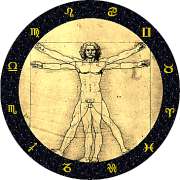Weboteric - Astrology
|
 |

Astrology - Uranus
First Ruler of the Gods
So distant that it can scarce be seen, blue green like Earth, yet cold - so cold.
Its symbol shows the cross of matter above the circle of spirit between the columns of Good and Evil (or Light and Dark)
Mythology
Sky Uranus begot out of Earth Ge the older generation of the gods, who were named Titans, but he would not withdraw himself from Earth to allow her to give birth.
The primeval separation of Heaven and Earth was achieved by the Titan Cronus, who became the Roman god Saturn, with his mother's aid when he castrated Ouranos [Uranus] with a great sickle.
So began the strife and successions of the gods.
“...Cronos, according to tradition, is the son of Uranus; but the upward gaze is rightly called by the name urania...and the astronomers say...that from this looking people acquire a pure mind."
Socrates. Plato, Cratylus 396 bc
Effects of Uranus
First of the Modern planets - those discovered in modern times and not visible with the naked eye - although Uranus can just be seen by those with keen eyesight on clear nights who know where to look.
From an astrological point of view, little is known about the trans-Saturnians or 'modern' planets. Therefore, they are considered with caution and are secondary to the seven traditional planets.
Following their discovery, modern astrologers have often tried to include
them into the traditional scheme but opinion is mixed about their effect
and if they should be included into calculation at all.
Astrology always has been a geocentrically based system about how the heavens
appear to us on Earth, not about how they are in astronomical reality. Therefore,
since these planets can't be seen with the naked eye, would they have been
accepted into the scheme had the ancients known about them?
The philosophy of astrology has always been about understanding 'As Above,
So Below' with emphasis on arbitrarily defined constellations. Yet the mystery
of why separate cultures divided by time and distance should all arrive
at twelve signs of the zodiac (even if named and shaped differently) remains.
However, it would be wrong to discount them entirely, although in most cases
they seem to achieve little more than add to the traditional planets' effects.
As Uranus takes 84 years to go around the Sun, it will be in any one sign for 7 years - therefore its effect is on a collective level, influencing successive generations. Uranus is often associated with revolutions and its sign position shows in what psychological area of humanity revolutionary changes will take place. It is the harbinger of sudden and unpredictable events and electric and lightning in its effect.
On a personal level its influence is to raise personal consciousness and can show where you are most original and where sudden developments will raise your consciousness. It represents the drive to be unique, to shock and to surprise.
How Uranus will manifest its energy depends on the horoscope as a whole. The Sign (and its Element), the House in which it falls, and the Aspects to the other planets will all have a bearing on any interpretation.
Uranus represents Originality, Inspiration, Dynamism, Independence, Will and Eccentricity.
Uranus Key Facts |
|
Rules: |
|
Detriment: |
|
Exhalt: |
|
Fall: |
|
Colours: |
Light blues, silvery white |
Stones & Metals: |
Amber, uranium |
Keywords: |
Destruction, re-evolution, sixth sense |
Astronomy
The first planet discovered in modern times by William Herschel while he was systematically searching the sky with his telescope on March 13, 1781.
It had actually been seen many times before but ignored as simply another star (the earliest recorded sighting was in 1690 when John Flamsteed catalogued it as 34 Tauri).
Herschel named it "the Georgium Sidus" (the Georgian Planet) in honour of his patron, King George III of England; others called it "Herschel".
Uranus is the seventh planet from the Sun and the third largest (by diameter). Uranus is larger in diameter but smaller in mass than Neptune.
Daylength (rotation) |
17.24 Hours |
||||||||||||||||||||||||||||||||||||||||||||||||||||||||||||||||||
Year length |
84.01 Years |
||||||||||||||||||||||||||||||||||||||||||||||||||||||||||||||||||
Distance from the sun (average) |
1,786 million miles (2,875 Million KM) |
||||||||||||||||||||||||||||||||||||||||||||||||||||||||||||||||||
Distance from Earth (shortest) |
1,607 million miles (2,587 Million KM) |
||||||||||||||||||||||||||||||||||||||||||||||||||||||||||||||||||
Distance from Earth (greatest) |
1,961 million miles (3,156 Million KM) |
||||||||||||||||||||||||||||||||||||||||||||||||||||||||||||||||||
Size (Earth=1) |
4.1 |
||||||||||||||||||||||||||||||||||||||||||||||||||||||||||||||||||
Mass (Earth=1) |
14.5 |
||||||||||||||||||||||||||||||||||||||||||||||||||||||||||||||||||
Moons |
Uranus has 20 named moons plus 1 recently discovered one which has not yet been given an official name; it thus has the most known moons of any of the planets.
|


Copyright © Weboteric.com 2006 Webdesign by WebOneUK